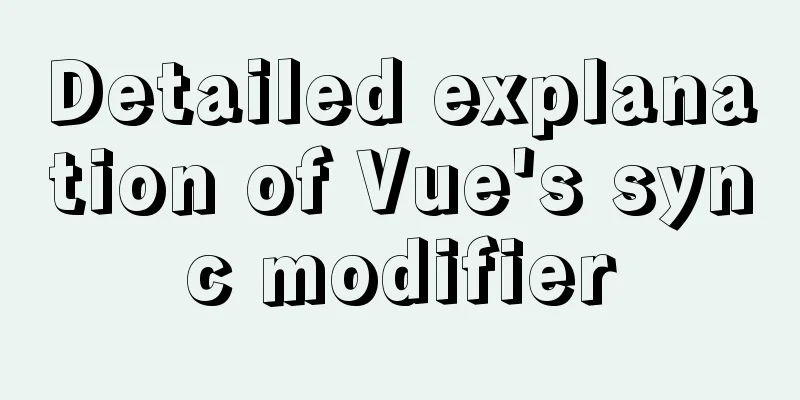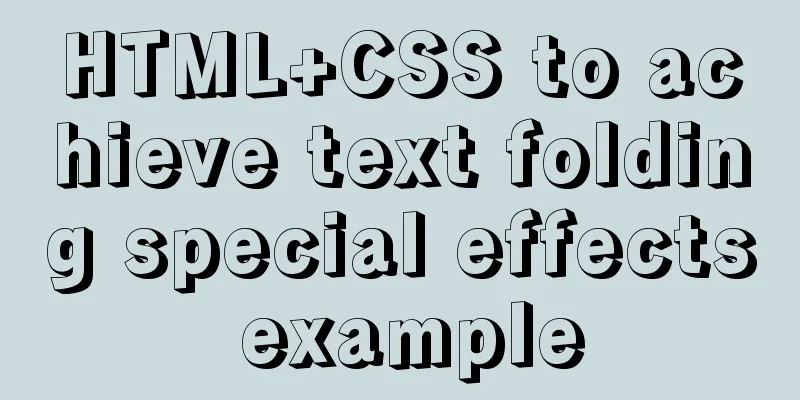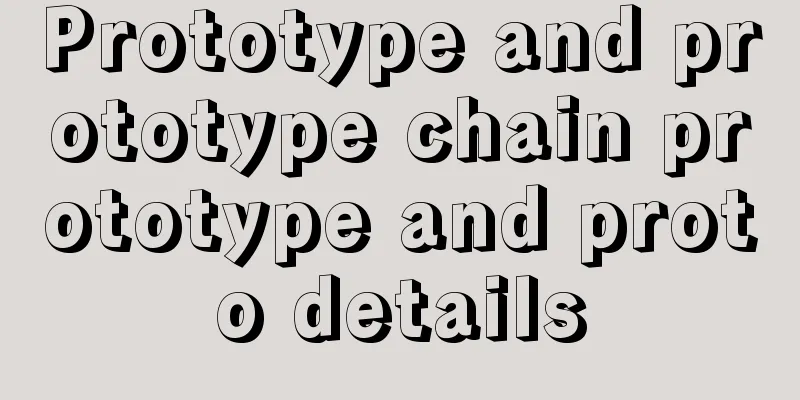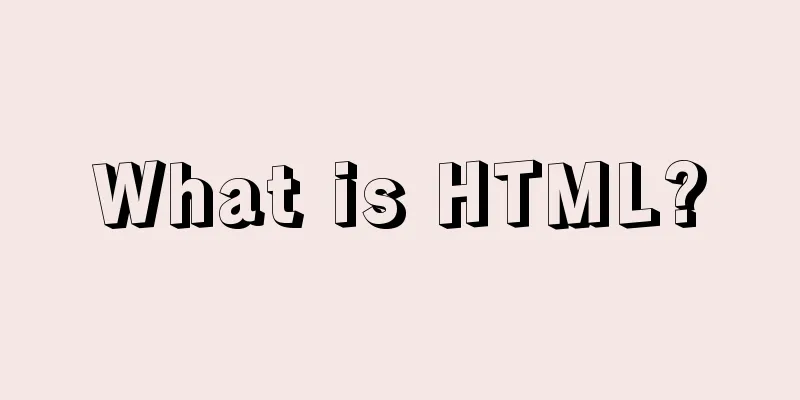Detailed explanation of Vue's sync modifier

1. Instructions An instruction is a directive. From the literal meaning, it means I tell you what to do. It is like sending an instruction, and then the person receiving the instruction just has to do it. Instructions in Vue have a unified and easy-to-recognize format, that is, instructions start with <div v-text="x"> </div> //v-text specifies the label text instruction<div v-on:click="add"> <div> //v-on event binding instruction But not all instructions start with v-. Some abbreviations are also instructions, such as <img :src="x"> </img> //shorthand for v-bind:src <button @click="add"> </button> //shorthand for v-on:click 2. ModifiersThe modifier is a syntactic sugar closely related to the event handling instruction v-on in the instruction. The so-called syntactic sugar is very sweet, simple and easy to use. In the programming world, it means that everything that can be done for you is done for you, leaving only the simplest things for you to do. In event handlers, there are some very common requirements, such as event.preventDefault() to prevent default events and event.stopPropagation() to prevent event bubbling, etc. Therefore, Vue takes care of these common requirements in the event processing process for us. When we need it, just tell Vue, and it will automatically help us prevent default events, prevent event bubbling, etc. Then the way we tell Vue is the modifiers that Vue provides us. The modifiers are represented by the instruction suffix starting with a dot. The preventDefault method example to prevent the default page refresh event of the <a> tag is as follows: Common practice <a href="" v-on:click=" rel="external nofollow" pe($event)">Vue click link</a> //To access the original DOM event in Vue, you can use the special variable $event to pass it into the method. In the original HTML, it is event // ...
methods: {
pe(e){
e.preventDefault()
}
}Using Modifiers <a v-on:click.prevent>Vue click link</a> //The prevent modifier is equivalent to the above e.preventDefault() From the above example, we can see that modifiers are syntactic sugar, which helps us write common requirements in advance and just say it when we need it. When there is an event handler, just continue writing it afterwards, as follows: <a href="" v-on:click.prevent=" rel="external nofollow" pp">Vue click link</a> // ...
methods: {
pp(){
console.log('Do not jump to page execution event')
}
}Modifiers are executed sequentially, such as the above v-on:click.prevent="pp", which means that when clicking, the modifier prevent is executed first to prevent the default event, and then the subsequent pp event processing function is executed. The modifiers correspond almost one-to-one to the relevant processing functions of the event. Depending on the event, the modifiers corresponding to different events are divided into several categories as shown below:
The origin and meaning of modifiers are as described above. As for the specific ones, you can go to the official website to find what you need when you actually use them. There are two most commonly used ones that need to be remembered, namely @click.stop is to prevent event bubbling, @click.prevent is to prevent the default event, and @keypress.enter is the key press Enter event. 3. .sync modifierThe .sync modifier is relatively special because it is not an evolution of the original event processing related functions of the event, but a modifier defined by Vue itself. For example, in the above modifier classification, .sync is also classified as a modifier of a custom event. So what exactly is this custom event? This event corresponds to the eventBus event. The eventBus event is a pattern in MVC. Simply put, it is a process of publishing and subscribing. That is, there are two parties. Party A is responsible for always listening to a certain event, and Party B is responsible for triggering this event when needed. Party A performs certain operations when it hears that the event is triggered. Party A is subscribing and Party B is publishing, and both parties are in a publish and subscribe model. So when would this be needed in Vue? That is, when a Vue component accepts external data props, Vue stipulates that the child component only has the right to use the data after accepting the external data through props, but does not have the right to modify the property. Because, if the child component modifies the data transmitted from the outside, then the child component and the parent file that uses it can be changed back and forth, and there is no obvious source of the change in the parent component and the child component. In the end, no one knows who changed the data, and the data becomes difficult to control. Therefore, Vue stipulates that components can only use the properties of props and cannot change them themselves. If they want to change, they must notify the real owner of the data to change, that is, the parent file that uses the component. The notification method used is the eventBus publish and subscribe mode. Not using .sync Subcomponent triggers an event. The event name format must be update:myPropName and is triggered using the $emit function. this.$emit('update:title', newTitle) //newTitle is the value you want to modify after the props data is modifiedThe parent component can listen to that event and update a local data property as needed. <myconponent :title="Ptitle" @update:title="Ptitle = $event" ></myconponent> //Listen to the event in the parent component. The value passed after the event is triggered is received as $event. $event === newTitle. Ptitle is the data of the parent component. Or the defined accept function parameters <myconponent :title="Ptitle" @update:title="val => Ptitle = val" ></myconponent> //The value received at this time is used as a parameter of the function Using .sync The above process is very common in actual needs, so Vue defines the parent component's listening as a value-passing modifier, .sync. The above code becomes: Subcomponents (same) this.$emit('update:title', newTitle)Parent Component <myconponent :title.sync="Ptitle"></myconponent> //Equivalent to passing values and monitoring above Isn’t it sweet? 4. SummaryRules for using .sync 1. Components cannot modify props external data 2. this.$emit can trigger events and pass parameters 3.$event can get the parameters of $emit The above is a detailed explanation of Vue's sync modifier. For more information about Vue's sync modifier, please pay attention to other related articles on 123WORDPRESS.COM! You may also be interested in:
|
<<: Summary of MySQL password modification methods
>>: Tips for viewing text in Linux (super practical!)
Recommend
Detailed explanation of JavaScript prototype and examples
Table of contents The relationship between the co...
Detailed explanation of the usage of MySQL data type DECIMAL
MySQL DECIMAL data type is used to store exact nu...
Mini Program to Implement Sieve Lottery
This article example shares the specific code of ...
How to install jupyter in docker on centos and open ports
Table of contents Install jupyter Docker port map...
Let's talk about the difference between containers and images in Docker
What is a mirror? An image can be seen as a file ...
Detailed explanation of firewall rule settings and commands (whitelist settings)
1. Set firewall rules Example 1: Expose port 8080...
WeChat applet custom bottom navigation bar component
This article example shares the specific implemen...
How to communicate between WIN10 system and Docker internal container IP
1. After installing the Windows version of Docker...
JavaScript implements simple date effects
The specific code of JavaScript date effects is f...
What does the n after int(n) in MySQL mean?
You may already know that the length 1 of int(1) ...
Three ways to configure JNDI data source in Tomcat
In my past work, the development server was gener...
How to implement cross-domain API proxy forwarding through Nginx proxy forwarding configuration
Preface In WEB development, we often involve cros...
Virtual domain name configuration and test verification under Linux\Nginx environment
By using Nginx virtual domain name configuration,...
Nginx stream configuration proxy (Nginx TCP/UDP load balancing)
Prelude We all know that nginx is an excellent re...
Steps to deploy Spring Boot project using Docker
Table of contents Create a simple springboot proj...










